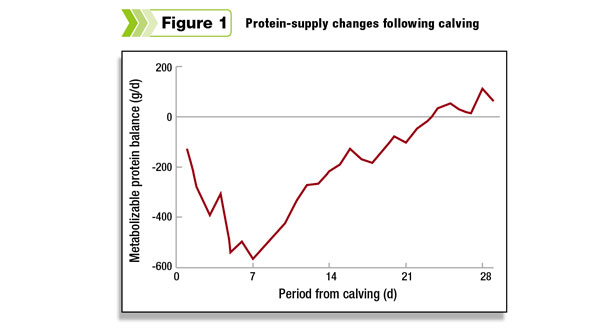Transition management directly impacts milk production and the bottom line. Poor transition periods can result in the loss of 10 to 20 pounds of peak milk per cow per day.
That’s significant – because for every pound of potential milk unrealized at peak production, the herd’s total milk production for the lactation decreases approximately 200 pounds. This could represent 2,000 to 4,000 pounds of potential milk lost per cow per lactation.
Cow management at transition is critical. It is closely linked to not only lactation performance but also to clinical and subclinical postpartum diseases and reproductive performance. Why?
Transition is a critical turning point. Cows move from non-lactating to lactating. There truly is a transition in the cow’s physiology, metabolism and nutritional requirements for three weeks prepartum until three weeks postpartum.
During the critical transition period, several factors deserve management’s focus. Prominent among these is the normal decrease in dry matter intake (DMI) as calving approaches. As DMI is compromised, a negative energy balance develops.
DMI can decrease at a rate of approximately 2 percent of bodyweight during the first several weeks of the dry period. This ramps up to 1.4 percent of bodyweight during the seven days prior to calving. As cows approach transition, an overall 30 percent decrease in DMI may seem to have occurred rapidly.
After calving, cows enter negative energy balance. For example, the energy requirement of a cow producing 55 pounds of milk per day just two days after calving is about twice as high as her energy requirement two days before calving.
The three weeks after calving, DMI is increasing at the rate of 3.3 pounds (1.5 kg) to 5.5 pounds (2.5 kg) per week, and negative energy balance corrects.
How do we assist cows in maintaining energy balance? One strategy is to use concentrated nutrients that take up less room in the already limiting dry matter space and to balance amino acid levels.
Balancing amino acids
Balancing for amino acids is an increasingly common ration management tool that benefits all cows. Proteins are built from amino acids and have numerous and varied roles in cows.
Today’s rumen-protected amino acid products are concentrated nutrients that take comparatively little space in the ration. Their positive effects on transition cows are continuing to be revealed by research.
At transition (Figure 1), if rations contain insufficient levels of amino acids and proteins, cows mobilize their limited protein reserves. These reserves are located in peripheral tissues and muscle.
 At transition, the synthesis of proteins and the efficiency of protein synthesis both increase, yet the diet should theoretically require a higher concentration of amino acids due to the reduced DMI.
At transition, the synthesis of proteins and the efficiency of protein synthesis both increase, yet the diet should theoretically require a higher concentration of amino acids due to the reduced DMI.
Rumen-protected amino acids can help ease this nutritional burden. During the last seven to 10 days of pregnancy, cows mobilize 1,000 grams of tissue every day. At the end of gestation, the uterus itself is extracting 72 percent of the amino acids in circulation.
Methionine and lysine are the first two limiting amino acids. In lactating cows, either histidine or arginine appears to be the next limiting. In transition cows, however, arginine is considered the next limiting after lysine and methionine.
Shortage versus excess
Insufficient supplies in the wrong quantities can limit herd production and performance. For example, methionine is important for immune function, milk protein synthesis and the formation of cysteine, an amino acid necessary for milk protein synthesis and immune system antioxidants.
When methionine is lacking and cysteine becomes limiting, cows can start to suffer from stress, inflammation and immunosuppression.
A shortage of lysine would be expected to first affect production, then reproduction and then the immune system. Eventually, it could affect all body functions and systems, as lysine is a building block of several proteins with widely varying purposes in the body.
Excess amino acid supplies have consequences too, so precision is important. An oversupply of methionine, for instance, throws off the balance of the lysine-to-methionine ratio and can have profound effects by further reducing DMI.
This is supported by the hepatic oxidation theory. This theory suggests cows will stop eating based on the signals carried from the liver to the brain.
These signals can be triggered when an excess supply of methionine is present and is not being used due to the limited lysine supply.
An approximately 3-to-1 ratio of lysine to methionine is strongly recommended for cows through the transition period. The exact ratio varies somewhat among the various commercial ration formulation software programs. The corresponding grams of lysine and methionine would be around 96 to 32 for prefresh and 180 to 60 after calving.
Precision
Several transition studies on amino acid nutrition have been presented at the annual meetings of the American Dairy Science Association in recent years. Let’s consider highlights: In one study (Table 1), cows were fed zero, 16 and 32 grams of supplemental lysine for the four weeks following calving.
 The resulting milk production was 81, 84 and 86 pounds, respectively. The milk volume response to lysine plateaued when the percent of lysine to metabolizable protein reached 7.67 and 8.36 – meaning the current recommendations might be too low. Further research is needed.
The resulting milk production was 81, 84 and 86 pounds, respectively. The milk volume response to lysine plateaued when the percent of lysine to metabolizable protein reached 7.67 and 8.36 – meaning the current recommendations might be too low. Further research is needed.
Following the treatments, all groups were fed the control diet. Interestingly, milk production for the cows initially supplemented with amino acids and the control cows converged. This indicates that proper use of amino acid nutrition is vital as lactation progresses.
In another transition study, with cows three weeks before calving until three weeks post-calving, cows were assigned treatments as follows:
- Control treatment pre- and post-calving
- Supplemental lysine pre- and control treatment post-calving
- Control treatment pre- and supplemental lysine post-calving
- Supplemental lysine pre- and post-calving
The results? The group receiving supplemental lysine pre-calving had a greater DMI after calving with a significantly reduced incidence of disease. The group that received supplemental lysine pre- and post-calving produced the most milk, with the control group producing the least amount of milk.
Future discussions of amino acid requirements through transition will likely expand beyond methionine and lysine as the industry focus shifts to which of the remaining 10 essential amino acids is next limiting – which is next in holding back production.
Arginine
In a transition study, arginine was infused daily at 0.1 g per kg bodyweight starting about seven days prior to the predicted calving date and ending at calving.
The arginine infusion caused a dramatic, but transient, increase in the concentrations of the blood serum prolactin, growth hormone and insulin. In addition, milk production for the first 22 weeks of lactation tended to be higher, about 10 percent, for cows infused with arginine as compared to cows infused with salt water.
Therefore, repeated arginine infusion in late-pregnant cows dramatically increased prolactin, growth hormone and insulin, and tended to increase subsequent milk yield.
Arginine has also been proven to have effects on reproduction, as it is a precursor for nitric oxide production, which stimulates more blood flow to the uterus, resulting in improved reproductive performance.
Transition is and will continue to be the most challenging time in the lactation cycle of dairy cows. However, new nutritional strategies can help lessen the effects and prepare cows to more-than-ever-before reach their full production potential.
Precisely producing more nutrients in the limited amount of diet space available holds the future to higher production and performance. PD

-
Jessica Tekippe
- Product Manager
- Ajinomoto Heartland Inc.
- Email Jessica Tekippe






